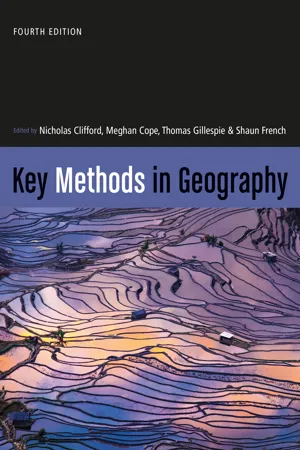
Key Methods in Geography
- 784 pages
- English
- ePUB (mobile friendly)
- Available on iOS & Android
Key Methods in Geography
About this book
Key Methods in Geography is the perfect introductory companion, providing an overview of qualitative and quantitative methods for human and physical geography. The fourth edition of this essential and accessible primer covers the breadth of the discipline and offer critical and contextual perspectives on research methods. New coverage takes account of newer technologies and practice, and 9 new chapters bring greater diversity of positionality and perspective to the volume, including decolonial methods, predicting, visualizing and modelling climate and environmental change, and writing up research. Case study examples, summaries and exercises have been included in each chapter to enable learning.
This is vital reading for any student undertaking a Geography Methods module as well as a valuable resource for any student embarking on independent research as part of their degree.
Frequently asked questions
- Essential is ideal for learners and professionals who enjoy exploring a wide range of subjects. Access the Essential Library with 800,000+ trusted titles and best-sellers across business, personal growth, and the humanities. Includes unlimited reading time and Standard Read Aloud voice.
- Complete: Perfect for advanced learners and researchers needing full, unrestricted access. Unlock 1.4M+ books across hundreds of subjects, including academic and specialized titles. The Complete Plan also includes advanced features like Premium Read Aloud and Research Assistant.
Please note we cannot support devices running on iOS 13 and Android 7 or earlier. Learn more about using the app.
Information
Table of contents
- Cover
- Half Title
- Publisher Note
- Title Page
- Copyright Page
- Contents
- About the Editors
- About the Contributors
- Preface and Acknowledgements
- Section One Starting Points and Perspectives
- 1 Getting Started in Geographical Research: How This Book Can Help
- 2 Health, Safety and Risk in the Field
- 3 On Being Ethical in Geographical Research
- 4 Identifying and Reviewing the Key Literature for Your Assignment
- 5 Effective Research Communication
- 6 Fundamentals of Mapping and GIS
- 7 Decolonial Methods
- Section Two Exploring Human and More-Than-Human Geographies
- 8 Historical and Archival Research
- 9 Conducting Questionnaire Surveys
- 10 Semi-Structured Interviews and Focus Groups
- 11 Respondent Diaries
- 12 Participant Observation
- 13 Researching Affect and Emotion
- 14 More-Than-Human Research Methodologies
- 15 Textual Analysis
- 16 Interpreting the Visual
- 17 Using Digital Social Data in Geographical Research
- 18 GeoHumanities and Creative Research Methods
- 19 Critical GIS*
- 20 Quantitative Modelling in Human Geography
- Section Three Exploring the Physical Environment
- 21 Making Observations and Measurements in the Field
- 22 Uncrewed Aircraft Systems (UAS) for Predicting, Visualizing and Modelling Environmental Change
- 23 Getting Information From the Past: Palaeoecological Studies of Terrestrial Ecosystems
- 24 Numerical Modelling: Understanding Explanation and Prediction in Physical Geography
- 25 Simulation and Reduced Complexity Models
- 26 Remote Sensing and Satellite Earth Observation
- 27 Digital Terrain Analysis
- 28 Environmental GIS
- 29 Models and Data in Biogeography and Landscape Ecology
- 30 Environment and Sustainability: Environmental Auditing, Impact Assessment and Valuation Revised
- Section Four Geographical Analysis: Interpreting, Visualizing and Representing Geographical Data
- 31 Making Use of Secondary Data
- 32 Using Statistics to Describe and Explore Spatial Data
- 33 Exploring and Presenting Quantitative Data
- 34 Case Study Methodology
- 35 Making Sense of Qualitative Data: Coding, Organizing and Analysing
- 36 Video, Audio and Technology-Based Applications
- 37 Writing: An Embodied Spatial Practice of Scholarly Sharing
- Section Five Perspectives on Research in Practice
- 38 Encountering the Digital in Human Geography Research
- 39 Doing Engaged Scholarship: Why Methods Matter
- 40 Conclusion
- Index